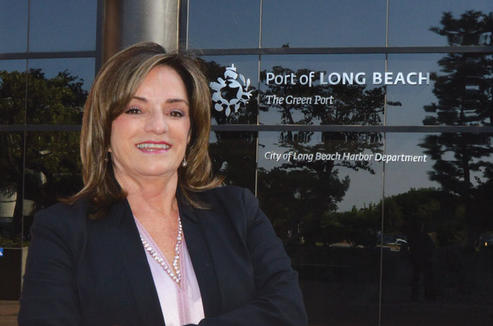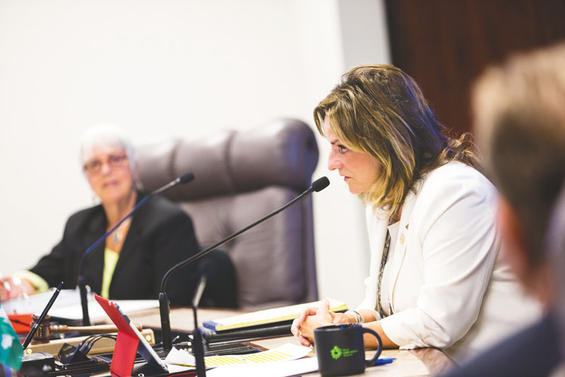As president of the Long Beach Board of Harbor Commissioners, which oversees the Port of Long Beach (POLB), Lou Anne Bynum is a business leader with international reach. Just last week, she traveled to South Korea and Japan alongside POLB Executive Director Mario Cordero and Mayor Robert Garcia to meet with clients of the port. Bynum has served on the harbor commission since 2014, when then-Mayor Bob Foster appointed her to the board.
Bynum is one of four women on the majority female board. With the recent appointment of former Assemblymember Bonnie Lowenthal, this is the first time in the port’s history that its board has been comprised of a four-fifths majority female board.
“I can’t think of any other commissions that have this kind of majority of women. And when you get out of the United States, I think it’s very unusual to see something like that,” Bynum said during an interview at the port’s interim headquarters near the Long Beach Airport. “Not only are we a global leader for being a green port and sustainable and innovative, but we are leading in this area in making sure that women have as much opportunity and leadership roles as men do, traditionally.”

Lou Anne Bynum is the president of the Long Beach Board of Harbor Commissioners. (Photograph by the Business Journal’s Larry Duncan)
Abroad, the international trade industry is much more male dominated, according to Bynum. “[During] the first trip I took to Europe, we met with five or six different customers, and there weren’t any women involved in any of the positions [with organizations] that we met with,” she recalled.
“But again, I think we’re a leader in being able to make some of those changes. I think it’s a little bit of a surprise for customers to see so many female commissioners but, once we get into business, it’s all the same.”
As president of the board, a position she assumed in August, Bynum anticipates traveling more than she did previously. Freeing up her schedule somewhat is her recent retirement from a 20-year career at Long Beach City College, where she had served as executive vice president of college advancement and workforce development since 2012.
“We just came back from a trip to Asia, and it’s always so enlightening to meet with customers, the big shipping lines, face to face and have conversations with them about trends in the industry, and where they are going and what do they see,” Bynum said, referring to a trip to Shanghai and Singapore.
Noting that she has served on the board of harbor commissioners for four years now, Bynum observed that, despite some progress, she has yet to see a significant influx of women in international trade-related fields. And, in general, women still have to overcome obstacles in the workforce to reach parity with men.
“I was reading an article the other day that women now have gone from [earning] 79 cents to the dollar to 80 cents to the dollar to men,” Bynum said, noting that this statistic was specific to Caucasian men and women. “But when you put African American and Latina women in, it’s about 66 cents to the dollar. So, we have made progress, but there is a long way to go. And there is a long way to go in leadership positions and in STEM [science, technology, engineering and math] positions.”
Although Bynum views education as a “great leveler for people to have opportunity,” she noted that even women with degrees enter the workforce at lower pay scales than men. “In general, there is just a lot of work that needs to be done in business [toward achieving parity],” she said.
The Port of Long Beach has internal and outreach programs to help women gain opportunities in international trade. Its internal program, Women’s Leadership Circle, is open to any port staff member. The program hosts guest speakers like Bynum, and also helps women identify opportunities for advancement.
“The leadership program has done a great job of being able to help some of our women employees here at the port, number one, recognize that they have more opportunity than what they are doing right now in their current job and, number two, actually being able to compete successfully for promotional opportunities,” Bynum said.
“Women sometimes get stuck in positions and roles and don’t realize that just with a little bit of pivoting they can have different kinds of opportunities,” Bynum said, adding that this observation comes from decades of experience in the workforce. “I think women don’t see the same kinds of opportunities perhaps that men do. Maybe they aren’t mentored in quite the same way, recognizing the networking that goes on.”
The port’s annual Women In Trade luncheon was started seven years ago to give local young women the chance to learn about international trade industry opportunities, and learn from professional women working in the field. This year’s luncheon is set to host nearly 400 students from local high schools and Long Beach City College.
“We have young students who live on Santa Fe Avenue. And at the end of Santa Fe Avenue, you can see Middle Harbor and its cranes. They don’t even realize what’s going on there – that there is a port that is engaged in that kind of opportunity and activity,” Bynum said.
“It’s all about introducing young women to professional women who work in the industry, as well as opportunities in the industry,” she said of the luncheon, which features a panel discussion with participants from a variety of backgrounds, such as a crane operator, an engineer, a U.S. Customs and Border Protection officer, and others.
“Young people tend to look at the port and they think well, it’s just a container coming in and going someplace. But it’s security, it’s finance, it’s HR. It’s engineering. There is so much opportunity,” Bynum said.
Two years ago, the Port of Long Beach partnered with the Center for International Trade and Transportation at California State University, Long Beach to create a new academy at Cabrillo High School centered around global logistics. The port has also given nearly $200,000 in scholarships to local youth over the years, Bynum added. “I am so proud of the port and what they have done for that kind of outreach,” she said. “They really are a model for other businesses.”
To gain a better understanding of the port’s economic impact, the board recently commissioned a study to update 10-year old data. “I am really looking forward to that, because I think it’s going to show that there is even a much larger impact from the economic activity at the port and where we’re going with that,” Bynum said. She estimated that the study should be completed within the next year.
Priorities For The Harbor Commission
On November 2, the boards of harbor commissioners of both San Pedro Bay ports are set to meet and vote on the updated Clean Air Action Plan (CAAP), which plots out a path to zero emission operations by 2035. Bynum said that the draft is “getting there,” and that she expects the final version to be “a good plan.”
“I have spent a lot of time, as have the other commissioners, meeting with stakeholders,” Bynum said. “I think we all want to get to zero emissions. The question becomes: how do we do that in a way that’s feasible?”
Bynum said there are concerns about costs to industry and the ports’ ability to remain competitive if the plan goes forward. “I think the commission has a responsibility to make sure we do everything we can to get funds to be able to mitigate the cost to our customers,” she said. She noted that the plan includes feasibility assessments to analyze technological advancements and costs as the CAAP is implemented.
Shifts in the shipping industry, including new shipping alliance structures and the opening of the Panama Canal, pose additional challenges to competitiveness, she pointed out. “We have to up our game with our customers and make sure that we are providing the kind of service that they need. And you know, the ability to bring a big ship in and offload it and get it out quickly is really important too,” she said.

Lou Anne Bynum presides over a meeting of the Long Beach Board of Harbor Commissioners, of which she is president. At her left is recently appointed Commissioner Bonnie Lowenthal, a former state assemblymember and Long Beach councilmember. Four members of the five-member board are women. (Photograph courtesy of the Port of Long Beach)
The port is in the midst of a $4.5 billion capital improvement plan with two major projects, the redevelopment of Middle Harbor and the replacement of the Gerald Desmond Bridge, aimed at accommodating bigger vessels. Moving forward, Bynum said developing more rail infrastructure will be key in ensuring cargo moves quickly after being offloaded from larger vessels. Rail also offers some environmental benefits, she noted.
With so many projects planned and underway, Bynum pointed out that the commission keeps a watchful eye over the port’s finances. “Financial stability and being able to function and make sure we can pay our bills and help our customers is really important to us. But I have a lot of confidence in the financial backdrop to the port right now,” she said.
Although Bynum has already received offers of consulting work following her recent LBCC retirement, she said most of her time now is going to be devoted to her role as president of the board. “I want to focus and concentrate on the port and my responsibilities on the commission as president this year,” she said.
“One of the things that I am most thankful for was the opportunity to be able to build an economic workforce development program,” she said of her time at the city college. “One of the things about Long Beach City College is that we were able to put all the economic workforce development opportunities under one administrative umbrella. That allowed us to leverage opportunities. And so, consequently, we grew from $2 million in workforce programs to $8 or $10 million in workforce programs now,” she reflected.
Workforce programs put in place during Bynum’s tenure included the Goldman Sach’s 10,000 Small Businesses program, the Small Business Development Center, an international business accelerator, an international trade e-commerce program, and “a whole legacy of programs,” according to Bynum. “For me, if I can walk away and that just gets better and we help our community more, that’s something I feel really good about,” she said.
Bynum may take on some part-time consulting work with educational institutions in the future. “But that’s after I do my due diligence here at the port,” she said.
